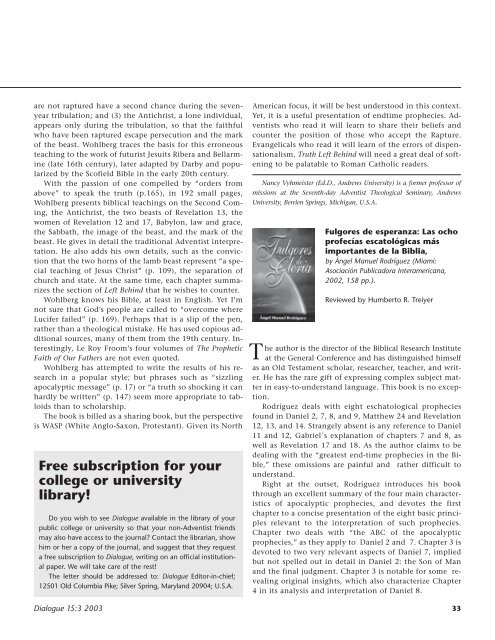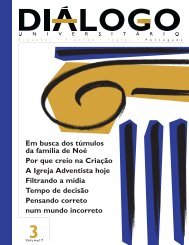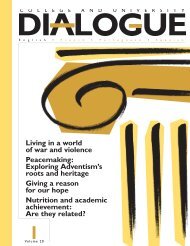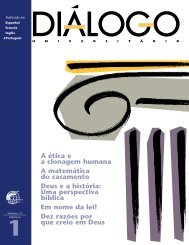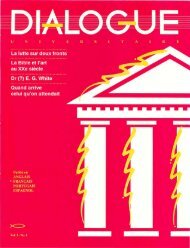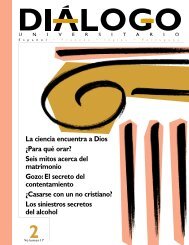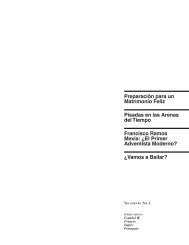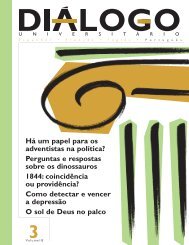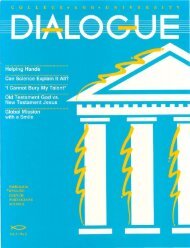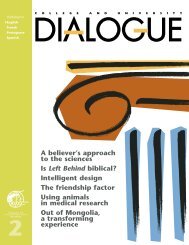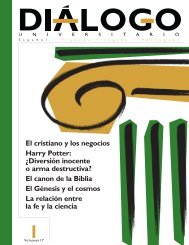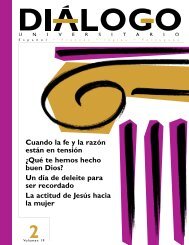Faith, reason, and the educated Christian Creationism - College and ...
Faith, reason, and the educated Christian Creationism - College and ...
Faith, reason, and the educated Christian Creationism - College and ...
Create successful ePaper yourself
Turn your PDF publications into a flip-book with our unique Google optimized e-Paper software.
are not raptured have a second chance during <strong>the</strong> sevenyear<br />
tribulation; <strong>and</strong> (3) <strong>the</strong> Antichrist, a lone individual,<br />
appears only during <strong>the</strong> tribulation, so that <strong>the</strong> faithful<br />
who have been raptured escape persecution <strong>and</strong> <strong>the</strong> mark<br />
of <strong>the</strong> beast. Wohlberg traces <strong>the</strong> basis for this erroneous<br />
teaching to <strong>the</strong> work of futurist Jesuits Ribera <strong>and</strong> Bellarmine<br />
(late 16th century), later adapted by Darby <strong>and</strong> popularized<br />
by <strong>the</strong> Scofield Bible in <strong>the</strong> early 20th century.<br />
With <strong>the</strong> passion of one compelled by “orders from<br />
above” to speak <strong>the</strong> truth (p.165), in 192 small pages,<br />
Wohlberg presents biblical teachings on <strong>the</strong> Second Coming,<br />
<strong>the</strong> Antichrist, <strong>the</strong> two beasts of Revelation 13, <strong>the</strong><br />
women of Revelation 12 <strong>and</strong> 17, Babylon, law <strong>and</strong> grace,<br />
<strong>the</strong> Sabbath, <strong>the</strong> image of <strong>the</strong> beast, <strong>and</strong> <strong>the</strong> mark of <strong>the</strong><br />
beast. He gives in detail <strong>the</strong> traditional Adventist interpretation.<br />
He also adds his own details, such as <strong>the</strong> conviction<br />
that <strong>the</strong> two horns of <strong>the</strong> lamb beast represent “a special<br />
teaching of Jesus Christ” (p. 109), <strong>the</strong> separation of<br />
church <strong>and</strong> state. At <strong>the</strong> same time, each chapter summarizes<br />
<strong>the</strong> section of Left Behind that he wishes to counter.<br />
Wohlberg knows his Bible, at least in English. Yet I’m<br />
not sure that God’s people are called to “overcome where<br />
Lucifer failed” (p. 169). Perhaps that is a slip of <strong>the</strong> pen,<br />
ra<strong>the</strong>r than a <strong>the</strong>ological mistake. He has used copious additional<br />
sources, many of <strong>the</strong>m from <strong>the</strong> 19th century. Interestingly,<br />
Le Roy Froom’s four volumes of The Prophetic<br />
<strong>Faith</strong> of Our Fa<strong>the</strong>rs are not even quoted.<br />
Wohlberg has attempted to write <strong>the</strong> results of his research<br />
in a popular style; but phrases such as “sizzling<br />
apocalyptic message” (p. 17) or “a truth so shocking it can<br />
hardly be written” (p. 147) seem more appropriate to tabloids<br />
than to scholarship.<br />
The book is billed as a sharing book, but <strong>the</strong> perspective<br />
is WASP (White Anglo-Saxon, Protestant). Given its North<br />
Free subscription for your<br />
college or university<br />
library!<br />
Do you wish to see Dialogue available in <strong>the</strong> library of your<br />
public college or university so that your non-Adventist friends<br />
may also have access to <strong>the</strong> journal? Contact <strong>the</strong> librarian, show<br />
him or her a copy of <strong>the</strong> journal, <strong>and</strong> suggest that <strong>the</strong>y request<br />
a free subscription to Dialogue, writing on an official institutional<br />
paper. We will take care of <strong>the</strong> rest!<br />
The letter should be addressed to: Dialogue Editor-in-chief;<br />
12501 Old Columbia Pike; Silver Spring, Maryl<strong>and</strong> 20904; U.S.A.<br />
Dialogue 15:3 2003<br />
American focus, it will be best understood in this context.<br />
Yet, it is a useful presentation of endtime prophecies. Adventists<br />
who read it will learn to share <strong>the</strong>ir beliefs <strong>and</strong><br />
counter <strong>the</strong> position of those who accept <strong>the</strong> Rapture.<br />
Evangelicals who read it will learn of <strong>the</strong> errors of dispensationalism.<br />
Truth Left Behind will need a great deal of softening<br />
to be palatable to Roman Catholic readers.<br />
Nancy Vyhmeister (Ed.D., Andrews University) is a former professor of<br />
missions at <strong>the</strong> Seventh-day Adventist Theological Seminary, Andrews<br />
University, Berrien Springs, Michigan, U.S.A.<br />
Fulgores de esperanza: Las ocho<br />
profecías escatológicas más<br />
importantes de la Biblia,<br />
by Ángel Manuel Rodríguez (Miami:<br />
Asociación Publicadora Interamericana,<br />
2002, 158 pp.).<br />
Reviewed by Humberto R. Treiyer<br />
T<br />
he author is <strong>the</strong> director of <strong>the</strong> Biblical Research Institute<br />
at <strong>the</strong> General Conference <strong>and</strong> has distinguished himself<br />
as an Old Testament scholar, researcher, teacher, <strong>and</strong> writer.<br />
He has <strong>the</strong> rare gift of expressing complex subject matter<br />
in easy-to-underst<strong>and</strong> language. This book is no exception.<br />
Rodríguez deals with eight eschatological prophecies<br />
found in Daniel 2, 7, 8, <strong>and</strong> 9, Mat<strong>the</strong>w 24 <strong>and</strong> Revelation<br />
12, 13, <strong>and</strong> 14. Strangely absent is any reference to Daniel<br />
11 <strong>and</strong> 12, Gabriel´s explanation of chapters 7 <strong>and</strong> 8, as<br />
well as Revelation 17 <strong>and</strong> 18. As <strong>the</strong> author claims to be<br />
dealing with <strong>the</strong> “greatest end-time prophecies in <strong>the</strong> Bible,”<br />
<strong>the</strong>se omissions are painful <strong>and</strong> ra<strong>the</strong>r difficult to<br />
underst<strong>and</strong>.<br />
Right at <strong>the</strong> outset, Rodríguez introduces his book<br />
through an excellent summary of <strong>the</strong> four main characteristics<br />
of apocalyptic prophecies, <strong>and</strong> devotes <strong>the</strong> first<br />
chapter to a concise presentation of <strong>the</strong> eight basic principles<br />
relevant to <strong>the</strong> interpretation of such prophecies.<br />
Chapter two deals with “<strong>the</strong> ABC of <strong>the</strong> apocalyptic<br />
prophecies,” as <strong>the</strong>y apply to Daniel 2 <strong>and</strong> 7. Chapter 3 is<br />
devoted to two very relevant aspects of Daniel 7, implied<br />
but not spelled out in detail in Daniel 2: <strong>the</strong> Son of Man<br />
<strong>and</strong> <strong>the</strong> final judgment. Chapter 3 is notable for some revealing<br />
original insights, which also characterize Chapter<br />
4 in its analysis <strong>and</strong> interpretation of Daniel 8.<br />
33


